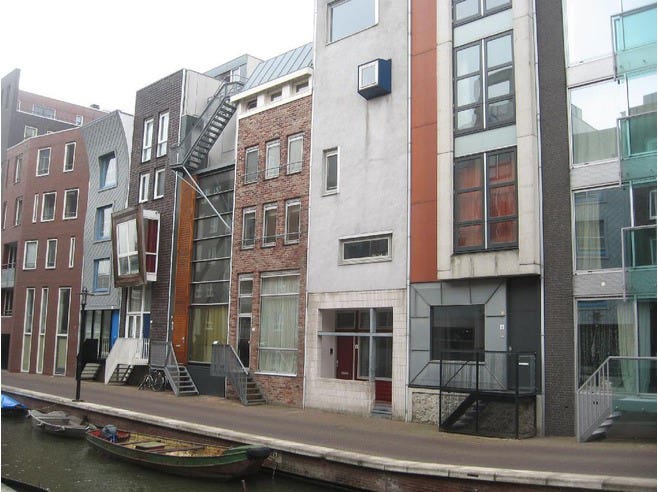
Clem Labine
When Modernism Is Deprived of Contrast
The moral of the following tale is: Context is everything! I was dismayed – as were many of my neighbors – to see a discordant new infill townhouse (see Fig. 1) under construction in the middle of a row of Brooklyn’s traditional brownstones. (The construction site is not in an official historic district and thus is not under landmark protection.) It was evident that the client and the architect wanted their design to be starkly differentiated from the other Victorian brownstones on the block. They wanted to make a bold personal statement – and they certainly succeeded. The structure demonstrates that the designer disdains contextual architecture, which would reinforce the existing character of the entire block, preferring instead the triumphant projection of individual ego.
Ironically, the adjacent historic brownstones at which the new townhouse thumbs its nose unwittingly also serve the architect’s intentions extremely well. The rhythmic facades of the traditional brownstones serve as a frame that sets off the Modernist design in bold relief and emphasizes the discontinuity of style. However, if looked at as a piece of stand-alone architecture – without the contrast of the Victorian brownstones – the new townhouse would appear rather banal, little more than a quotation from Modernist memes that have been around for many decades. But when the infill building is contrasted against the row of old Italianate houses, the new building takes on a radical demeanor. The infill townhouse needs the historic context to achieve its “shock of the new” effect.
Without a backdrop of contrasting historic architecture Modernism falls flat
Just how badly Modernist design requires historic context to achieve its full attention-getting potential is shown in Fig. 2, a development of new canal houses in the Java Island district of Amsterdam in the Netherlands. The developer wanted a totally “modern” look for his development, so he commissioned several architects to come up with “advanced” designs for a series of canal houses. The developer’s stated goal was “differentiation and unity.” He certainly got differentiation. And I suppose there is “unity” in that they are all obviously based on contemporary Modernism. But the composition lacks Modernism’s essential “shock of the new” effect. Because they are all intended to be avant-garde, none seems particularly radical or noteworthy.
Beyond that, lacking any shared design principles, the row is visual chaos, a contradictory jumble of geometric shapes and windows set in seemingly random patterns. If any one of these Modernist houses was inserted into a row of traditional Dutch canal houses (Fig. 3), it would indeed appear like innovative design. But when all these new canal houses are presented side-by-side, the grouping appears merely anarchic and purposeless, rather than progressive and forward-looking.
Compare the Java Island row with the row of traditional Amsterdam canal houses in Fig. 3. Each residence is different, with its own distinct look and style. But because they all employ a traditional three-bay façade design, the ensemble displays unified character and harmony. The underlying design tradition provides the “differentiation and unity” that are lacking in the Java Island row shown in Fig. 2. Now, if you plopped one of those Modernist canal houses into this traditional grouping, the new house would definitely detract from the unified character of the row. But the owner would at least have the ego-satisfaction of being really different.
Clem Labine is the founder of Old-House Journal, Clem Labine’s Traditional Building, and Clem Labine’s Period Homes. His interest in preservation stemmed from his purchase and restoration of an 1883 brownstone in the Park Slope section of Brooklyn, NY.
Labine has received numerous awards, including awards from The Preservation League of New York State, the Arthur Ross Award from Classical America and The Harley J. McKee Award from the Association for Preservation Technology (APT). He has also received awards from such organizations as The National Trust for Historic Preservation, The Victorian Society, New York State Historic Preservation Office, The Brooklyn Brownstone Conference, The Municipal Art Society, and the Historic House Association. He was a founding board member of the Institute of Classical Architecture and served in an active capacity on the board until 2005, when he moved to board emeritus status. A chemical engineer from Yale, Labine held a variety of editorial and marketing positions at McGraw-Hill before leaving in 1972 to pursue his interest in preservation.








